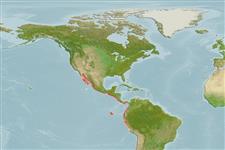Classification / Names
Common names from other countries
Main reference
Size / Weight / Age
Max length : 17.0 cm TL male/unsexed; (Ref. 96339); common length : 8.0 cm TL male/unsexed; (Ref. 55763)
Length at first maturity
Lm 6.0 range ? - ? cm
Environment
Marine; brackish; pelagic-neritic; depth range 0 - 142 m (Ref. 96339)
Climate / Range
Tropical, preferred ?; 31°N - 14°S, 115°W - 76°W (Ref. 189)
Distribution
Eastern Pacific: San Juanico Bay, northern Gulf of California southward to Callao, Peru and perhaps further south. The record from Santa Margarita Island on the Pacific coast of Baja California, Mexico is based solely on the now lost type of Stolephorus cultratus.
Countries | FAO areas | Ecosystems | Occurrences | Introductions
Short description
Dorsal
spines
(total): 0;
Anal
spines: 0;
Anal
soft rays: 20 - 25. Fairly elongate. Snout long, about 3/4 eye diameter or more; maxilla long, tip pointed, reaching almost to gill opening; gill cover canals of panamensis-type; pseudobranch longer than eye diameter, with 30 or more filaments, extending onto inner face of operculum. Anal fin origin under or just behind base of last dorsal fin ray. Silver stripe along flank about eye diameter.
IUCN Red List Status (Ref. 115185)
Threat to humans
Harmless
Human uses
Fisheries: minor commercial; bait: usually
More information
ReferencesAquacultureAquaculture profileStrainsGeneticsAllele frequenciesHeritabilityDiseasesProcessingMass conversion
Tools
Special reports
Download XML
Internet sources
Estimates of some properties based on models
Phylogenetic diversity index
PD50 = 0.5000 many relatives (e.g. carps) 0.5 - 2.0 few relatives (e.g. lungfishes)
Trophic Level
3.5 ±0.4 se; Based on size and trophs of closest relatives
Resilience
High, minimum population doubling time less than 15 months (Preliminary K or Fecundity.)
Vulnerability
Low vulnerability (10 of 100)
Price category
